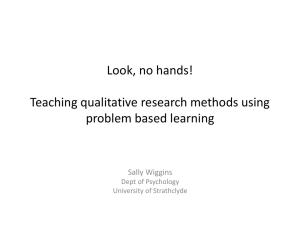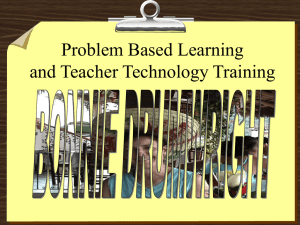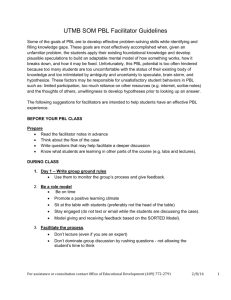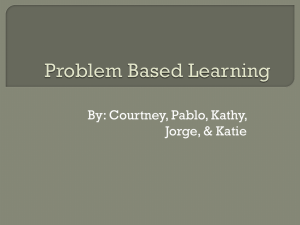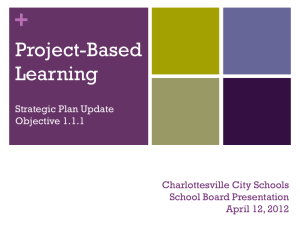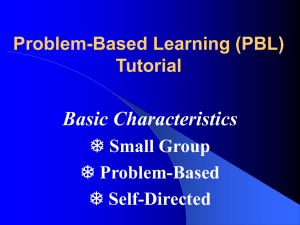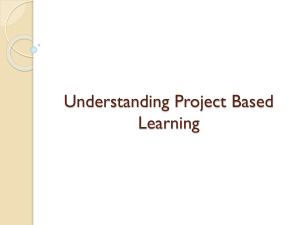The Journal of Distance Education. Studying
advertisement
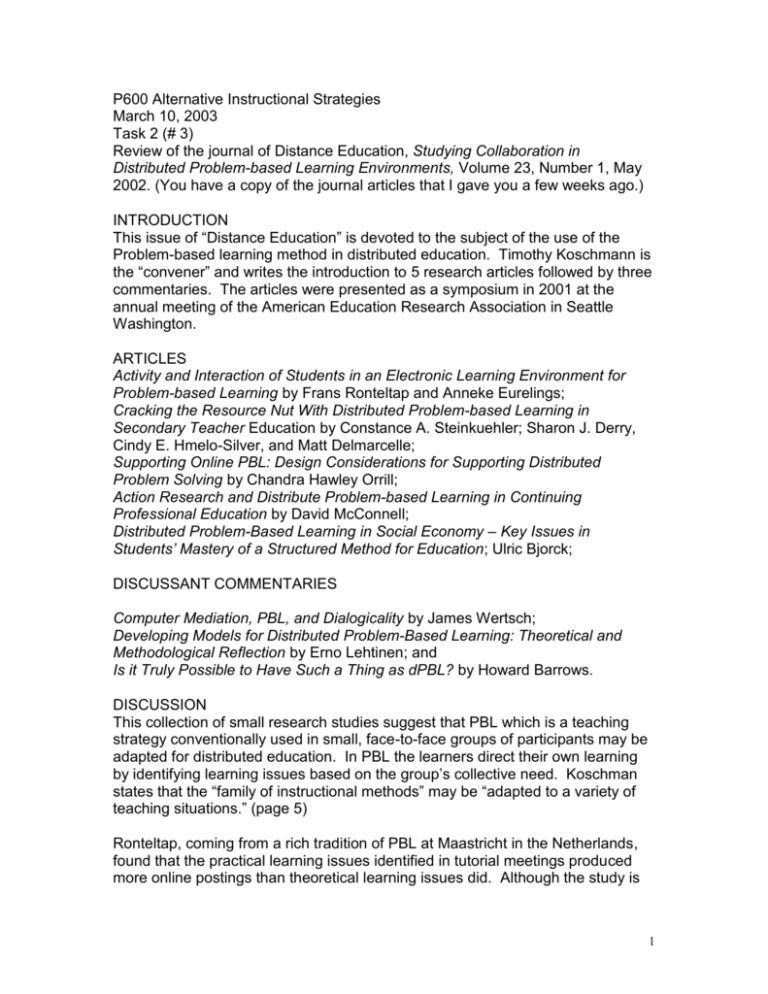
P600 Alternative Instructional Strategies March 10, 2003 Task 2 (# 3) Review of the journal of Distance Education, Studying Collaboration in Distributed Problem-based Learning Environments, Volume 23, Number 1, May 2002. (You have a copy of the journal articles that I gave you a few weeks ago.) INTRODUCTION This issue of “Distance Education” is devoted to the subject of the use of the Problem-based learning method in distributed education. Timothy Koschmann is the “convener” and writes the introduction to 5 research articles followed by three commentaries. The articles were presented as a symposium in 2001 at the annual meeting of the American Education Research Association in Seattle Washington. ARTICLES Activity and Interaction of Students in an Electronic Learning Environment for Problem-based Learning by Frans Ronteltap and Anneke Eurelings; Cracking the Resource Nut With Distributed Problem-based Learning in Secondary Teacher Education by Constance A. Steinkuehler; Sharon J. Derry, Cindy E. Hmelo-Silver, and Matt Delmarcelle; Supporting Online PBL: Design Considerations for Supporting Distributed Problem Solving by Chandra Hawley Orrill; Action Research and Distribute Problem-based Learning in Continuing Professional Education by David McConnell; Distributed Problem-Based Learning in Social Economy – Key Issues in Students’ Mastery of a Structured Method for Education; Ulric Bjorck; DISCUSSANT COMMENTARIES Computer Mediation, PBL, and Dialogicality by James Wertsch; Developing Models for Distributed Problem-Based Learning: Theoretical and Methodological Reflection by Erno Lehtinen; and Is it Truly Possible to Have Such a Thing as dPBL? by Howard Barrows. DISCUSSION This collection of small research studies suggest that PBL which is a teaching strategy conventionally used in small, face-to-face groups of participants may be adapted for distributed education. In PBL the learners direct their own learning by identifying learning issues based on the group’s collective need. Koschman states that the “family of instructional methods” may be “adapted to a variety of teaching situations.” (page 5) Ronteltap, coming from a rich tradition of PBL at Maastricht in the Netherlands, found that the practical learning issues identified in tutorial meetings produced more online postings than theoretical learning issues did. Although the study is 1 small there might be implications for selecting the material that is appropriate for online PBL learning. In Steinkuehler’s, et. al., study students identified problems independently then negotiated solutions in an online discussion that was moderated by a teaching assistant. In this study the role of the tutor specific to PBL was distributed across the group and learning environment. This study stretches the PBL method to an extreme that I question still meets the criteria of the method. (I’m thinking of the Savery and Duffy article from my Literature review) In the third study Orrill looked at the character of the contributions, changing the student’s understanding and the nature of the “idea units” in the student postings. Specifically he was interested in “knowledge centered pedagogy.” I am interested in knowing more specifics of how the method was implemented in this and the other studies. McConnell looked at the process of the online work, i.e., how work is organized over the course of the project, how cohesive the online community was, how the asynchronous format influenced the work, and if and how intermediate goals were set and achieved. Bjorck examined student actions in an asynchronous conference environment. He found that students took responsibility for their learning by “creating necessary artifacts.” He observed that students progressively established consensus, exchanged feedback, and were engaged. I am wondering how the evaluation was done to reach the conclusion that the students were engaged. Finally I think that Dr. Barrows raises excellent questions in his commentary: 1. “Is synchronous communication necessary . . .or can authentic dPBL occur without it?” 2. “What are the skills needed for the dPBL tutor as a facilitator, to make the method work and the learners comfortable and effective with the mediating technology?” 3. “Can a communication technology be developed that will mediate PBL, yet avoid distorting the PBL process as it is used in fact-to-face small-group work?” In addition Dr. Barrows believes that to have authentic dPBL the environment must be able to: Present an ill structured problem verbally, visually and auditorially as appropriate. Allow for both asynchronous and synchronous discussion Contain a white board operated by a group member to facilitate and record the group’s progress Ideas generated Data acquired Learning issues to be pursued. 2 I think that the online asynchronous environment is an environment within which the use of PBL can be achieved. However, to maintain the integrity of PBL as a strategy I agree with commentator Wertsch that the asynchronous online environment may introduce a “larger element of change into PBL, and its consequences for cognition, identity, and collaboration, than we recognize (p. 108).” Therefore I agree with the commentators that more study needs to be done. (I am sure that more has been done since this is a 2002 journal.) Moreover I think that Barrows gives us a good start with his list of questions and suggestions to maintain the integrity of the teaching strategy. I think the trends in using PBL are interesting. I think that it is beginning to grow in Schools of Nursing in the United States. Schools of nursing using PBL include Samford (Alabama), a university in Kentucky, and two majors in the Master in Nursing at IUPUI are a few of a limited number. Schools of Medicine in the US have a larger experience in using PBL. (nursing frequently follows medicine). Over the course of this semester I have learned (from Jaimie Kirkley) that the University of Southern Illinois (where Barrows retired from) is going to quit using PBL and that Indiana University School of Dentistry is also going to stop using PBL (John F. Chaves is leaving in April). Both decisions to stop using PBL are related to a changes in administration. This is an issue that I think I will write to Dr. John Savery. (another task I wanted to do “write to an expert” but until now I didn’t know what I wanted to ask about). Perhaps more importantly is that individual teachers are using the method. Hopefully they are getting some training and mentoring in the method to maximize the method for learning outcomes. This is a trend that I think is harder to track. In addition I am not sure that I understand why, or if, it is important that an entire discipline or department or major adopt the PBL format. I think that the appropriate strategy, in the trained hands, is a better approach. Different content lends itself to different types of strategies and that content and teacher ability and student mix should all play a part in deciding the teaching strategy to choose for particular lessons. 3

